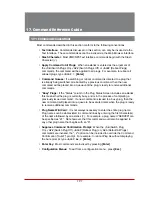
14-1
14. Creating Web Certificates
There are two different types of HTTPS security certificates: "Self Signed" certificates
and "Signed" certificates.
Note:
SSL/TLS parameters cannot be defined via the Web Browser Interface.
In order to set up SSL/TLS encryption, you must contact the VMR/NPS via the
Text Interface.
Self Signed certificates can be created by the VMR/NPS, without the need to go to an
outside service. The principal disadvantage of Self Signed certificates, is that when you
access the VMR/NPS command mode via the Web Browser Interface, the browser will
display a message which warns that the connection might be unsafe. Note however,
that even though this message is displayed, communication will still be encrypted, and
the message is merely a warning that the VMR/NPS is not recognized and that you may
not be connecting to the site that you intended.
Signed certificates must be created via an outside certificate authority (e.g., VeriSign
®
,
Thawte™, etc.) and then uploaded to the VMR/NPS unit to verify the unit's identity. Once
a signed certificate has been set up, you will then be able to access command mode
without seeing the warning message that is displayed for a Self Signed
certificate access.
WEB ACCESS: [eth0] IPv4/IPv6
HTTP:
1. Enable: On
2. Port: 80
HTTPS:
3. Enable: On
4. Port: 443
SSL Certificates:
5. Common Name:
6. State or Province:
7. Locality:
8. Country:
9. Email Address: 14. Harden Web Security: Medium
10. Organization Name: 15. TLS Mode: TLSv1.1/TLSv1.2
11. Organizational Unit: 16. TRACE Method: ON
12. CSR Commands:
13. CRT Commands:
Enter: #<CR> to change,
<ESC> to return to previous menu ...
Figure 14.1: Web Access Parameters (Text Interface Only)






























